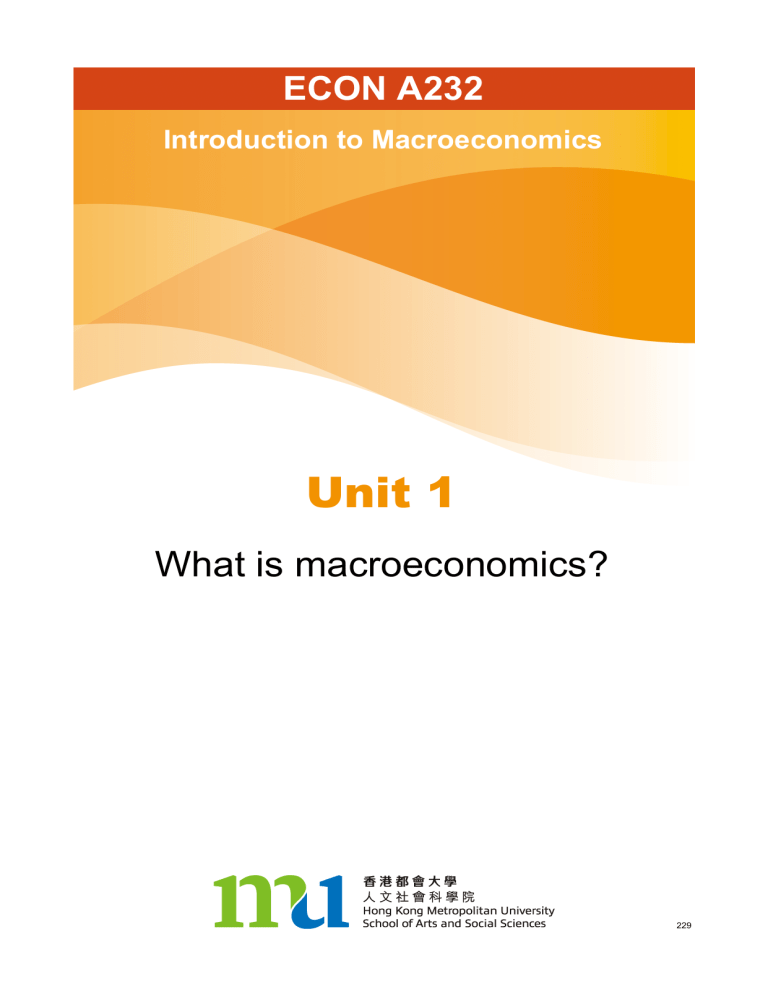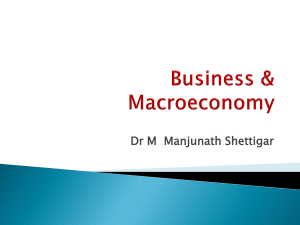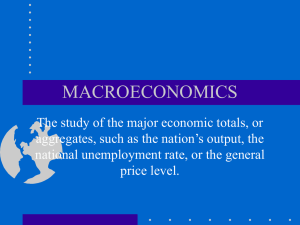
ECON A232 Introduction to Macroeconomics Unit 1 What is macroeconomics? 229 HKMU Course Team Course Development Coordinator Dr Eddie Cheung Chi-leung, HKMU, Developer Instructional Designer Ross Vermeer, HKMU Member Yuka Chan Ka-yu, HKMU Production Office for Advancement of Learning and Teaching (ALTO) Copyright © Hong Kong Metropolitan University, 2021. Reprinted 2022. All rights reserved. No part of this material may be reproduced in any form by any means without permission in writing from the President, Hong Kong Metropolitan University. Sale of this material is prohibited. Hong Kong Metropolitan University Ho Man Tin, Kowloon Hong Kong This course material is printed on environmentally friendly paper. Contents Introduction 1 How the economy as a whole works 2 Principle 8: A country’s standard of living depends on its ability to produce goods and services Principle 9: Prices rise when the government prints too much money Principle 10: Society faces a short-run trade-off between inflation and unemployment 2 3 3 The circular-flow model 5 Summary 6 Feedback on self-tests 7 Unit 1 Introduction Welcome to ECON A232 Introduction to Macroeconomics. There are six units in this course. This first unit is introductory in nature: it provides you with the basic background you will need to understand how the economy as a whole works. In the first of two sections, you will learn about some well-known observations economists have made in the past about the macroeconomy. The second section introduces a simple model that describes the macroeconomy. In sum, this unit: • relates a country’s standard of living to its productivity; • discusses why prices will rise when too much money is printed; • explains why there is a short-run trade-off between inflation and unemployment; and • explains the flows of funds in a macroeconomy with the circular-flow model. As you study this unit, you will need to follow the instructions and read the following chapters of your textbook: Mankiw, Chapter 1 and Chapter 2. 1 2 ECON A232 Introduction to Macroeconomics How the economy as a whole works The first reading for this unit comprises the second half of Chapter 1 from your textbook. The first few pages you will read list and describe some ‘microeconomic’ principles, which deal mainly with the decisions taken by individuals. In this course we care more about how the interaction of such individual decisions affect the economic welfare of the whole society. You will be introduced to three principles in your first textbook reading. These principles are basic observations that economists have made over the past decades that relate to arguably the three most important macroeconomic questions that concern an average worker — the level of income earned from work, the purchasing power of that income, and whether an individual can find employment. By bearing these principles in mind, you will have a much better idea of why we need to study the subject matter of the later units. Reading Mankiw, ‘Principle 8 to Principle 10’, 11–14. You have seen that the three observations you’ve just read about are Principles 8 to 10 from Chapter 1 of your textbook. Principles 1 to 7 relate to microeconomics, which are about economic choices made in individual markets, which are only a part of the whole economy. Even though these principles are not our focus in the study of macroeconomics, if you have not yet taken a microeconomics course, reading over these seven principles will help you better understand economics as a subject. Let’s now consider Principles 8 to 10 in a bit more detail. Principle 8: A country’s standard of living depends on its ability to produce goods and services This principle goes to the heart of the study of macroeconomics: it defines the standard of living as the aim of economic activity, and tells us about the long-term positive relationship between an average worker’s productivity and the average standard of living in a country. Essentially, the message to take home is that living standards depend on how much is produced within a certain period of time. The higher productivity is, the higher the living standard. Unit 1 Principle 9: Prices rise when the government prints too much money The issue of inflation is well-known to almost everyone because news about it appears very often in the press. The mechanisms that drive trends in inflation require more detailed study, which you’ll do in later units. Inflation, however, can be understood in a very simple way — when too much money is printed by the governing authorities, then the value of money declines relative to the goods that people buy. It takes more money to buy the same goods, hence inflation. A word of caution is in order when reading about this principle. Even though the textbook mentions that money is printed by the government, in modern day societies the money supply is usually presided over by the central bank, a specific, frequently independent, government body. In later units we will in fact distinguish clearly between ‘the government’ and ‘the central bank’. Principle 10: Society faces a short-run tradeoff between inflation and unemployment The last of the major concerns for workers in an economy is the prospect of finding work or protecting one’s job. Again, the actual mechanism behind this principle is the subject of detailed study in a later unit. What you should remember right now at this beginning stage of your study is that, in the short run of a few quarters or a couple of years, inflation and unemployment tend to go in different directions. Given that the central bank can more or less control the money supply, that means the unemployment rate can be manipulated too. We can explain this principle in a concise form — if the central bank prints lots of money, then it will find its way into people’s pockets, and it will be used to buy more goods and services. That spurs production because sellers will try to satisfy this extra demand. Higher production requires more workers, so the unemployment rate goes down. Activity 1.1 After reading about these three principles, you may feel that you have thought about these problems before. Everyone who has participated in the job market must have thought about securing (or wished to secure!) a job with stability, perhaps with less overtime work, but also with an acceptably high income. That means you were at once thinking about the possibility of unemployment and the standard of living — Principles 10 and 8, respectively, from the reading. However, even though news about the price level is common enough in the press, it seems difficult to relate anything we see in daily life with 3 4 ECON A232 Introduction to Macroeconomics Principle 9, because the author links it with the amount of money printed by the government. Can we find out anything meaningful about Principle 9? How would you do this? Principle 9 is actually all around us. To find out more about it, you could go to the websites of major news outlets, whether in Chinese or English, and browse through the financial pages for about one week consecutively. The HKMU Library has paid for subscriptions to a number of major newspapers from around the world. Try to see if you can identify any news about foreign currencies or interest rates. In fact, like changes in the price level, these two quantities are just different manifestations of the same actions carried out by the central bank in relation to the quantity of money. Your textbook tells us how the quantity of money can affect the price level in the local economy. At an international level, there are many different currencies in the world, and the quantity of different currencies can affect the exchange rates between them. The interest rate can actually be understood as the price to borrow money from other people (usually banks or on financial markets). Again, how much money there is in the economy can affect the price charged by lenders. You will learn about all of this in later units. You should now complete the following self-test before moving on the next topic in this unit. Do your best to answer all of the questions before checking the feedback provided at the end of this unit. Self-test 1.1 1 Suppose you are offered two similar job opportunities in two different countries. The Country A job pays $500,000 per year in salary, and the Country B job pays only $350,000. The general price level of goods and services is quite high in Country A, and considerably lower in Country B. From talking to your friends in these two places, you find that the lifestyle in Country A is hectic but exciting, and in Country B it is quiet and relaxed. Assuming that visa rules do not prevent you from taking either job, when you are deciding which job to take, what are some of the factors you will consider, and how do they relate to the three macroeconomic principles in this section? 2 One day, all of a sudden, the central bank announces that all monies in the country you are living in are now automatically multiplied by 1,000 times. In other words, if you had a five-dollar coin last night, you now have a $5,000 coin this morning. If you had $1,000 in the bank account yesterday, you are now a millionaire. What do you expect the prices of goods and services to be today? Unit 1 The circular-flow model The first economic model you will learn about in your study of macroeconomics attempts to link together different groups of people within the economy by studying the flow of funds and goods and services between them. An economic model is a simplification of real life; this means that only the important subject matter included, which makes it easier for us to understand. Please read the following section to learn more about this model. Reading Mankiw, ‘Our first model: The circular-flow diagram’, 22–24. As the last paragraph of the reading indicates, this is a very simple version of the circular-flow model. Sometimes this version is referred to as the ‘two-sector circular-flow model’ because it only contains two sectors, i.e. households and firms. Take note that even though we describe the people in the model as being divided into two groups, individual people of course belong to different groups at the same time, so these sectors are not exclusive. For example, you may be working for a company and engage in production during the day, so you form part of the firms sector — in fact, you are part of the factors of production that are hired by the firm. Once you go home after work, however, you are part of the households sector, and may engage in consumption decisions through spending money. This shows the interconnectedness of different sectors in the macroeconomy and illustrates a very important concept, i.e. that an economic decision usually has macroeconomic consequences on more than one group of people. Self-test 1.2 Suppose we are looking at an economy with a firms sector, a households sector, and a government. The government suddenly decides to spend $100 million in the economy by buying goods from local firms. According to the circular-flow model, how will you, as a worker in one such firm, be impacted? 5 6 ECON A232 Introduction to Macroeconomics Summary You’ve now completed the first unit of ECON A232 Introduction to Macroeconomics. You have seen the three fundamental macroeconomic issues that all workers are concerned about, and three economic principles that give some clue to how to assess them. In the next unit, you will learn how to measure them in real life, before moving on to explore some theories that seek to explain these observations. The idea that economic agents are all interconnected in an economy was also introduced to you in the form of the circular-flow model. This model shows clearly that when something happens to one section of the economy, all other parts are affected in different ways. In the later units, such connections are explored in much more detail. Unit 1 Feedback on self-tests Self-test 1.1 1 There are many things to consider, and not all of them are related to macroeconomics. Among those which are, we need to consider, for example, whether the higher income in Country A can compensate for the higher price level there. This requires us to apply Principle 9 because higher inflation in one country is likely to reduce the purchasing power of the income earned there. An associated question is what standard of living the income from these jobs will allow you to afford in these countries. The goods and services that are affordable form part of your assessment of the standard of living in these two countries. It is possible that if you prefer a more relaxed lifestyle, then you will find the quality of life in Country B better, in particular because goods are also cheaper there. This relates to Principle 8, and at the same time highlights some of the difficulty in applying it, since standard of living is subjective up to a point, and can only be measured and compared approximately. Job prospects may also be part of the consideration, as the macroeconomic environment or unemployment rate may be different in the two countries. If one country has considerably higher unemployment, then it is unlikely that a pay rise will be given in the near future in that job, and it may even affect your quality of life there. This related to Principle 10. Of course, there are many other non-macroeconomic considerations, but hopefully the above points allow you to see how macroeconomic principles have an important impact on job market decisions. 2 The prices of goods and services will immediately rise by 1,000 times. The reason is because everybody has 1,000 times the wealth overnight, without production of goods and services, or technology, changing at all. In later units, you will learn more details about different sectors of the economy, and consider some problems with adjustments of such prices in the short run, which may make the price level actually not move by 1,000 times. But as a first pass on using Principle 9, this simple insight will do for now. Self-test 1.2 As a worker in a local firm, part of the produce of your company will be bought by the government. That means the profit of the company you work for will increase, thereby increasing the chance that you may get your share through a large year-end bonus or a pay rise. At the same time, you are also part of a family within the households sector, so the higher income you may bring home can also lead to an increase in consumption, further increasing the profits of the local firms sector, and indirectly your future wages also. 7







